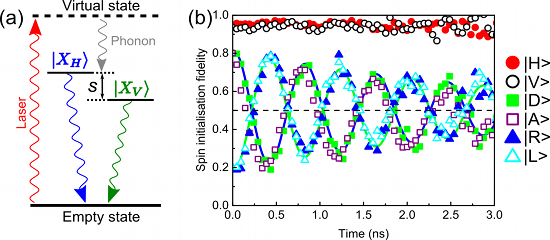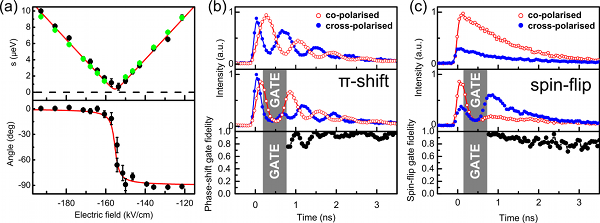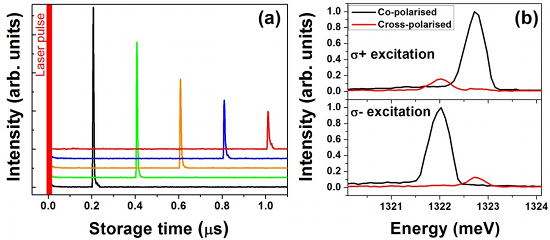Solid-state photonic interfaces based on single quantum dots and quantum dot molecules
Introduction
Extending the potential of quantum technologies require interfaces between different types of quantum bits (“qubits”), where reversible quantum conversion is used depending on the task to be performed. Optical “flying” qubits are for instance ideal for quantum communication, while solid-state “stationary” qubits are good candidates for quantum computations. Important applications requiring such interfaces include quantum memories, quantum repeaters, and distributed quantum processes.
Semiconductors constitute promising candidates as quantum interfaces between light and matter. Indeed, optical absorption of photons in a semiconductor to create an electron-hole pair (or exciton) provides a natural mechanism to transfer quantum information from optical fields into the solid-state as selection rules determine the mapping of the photon polarisation onto the spin state of the exciton.
Our research explores how to use single quantum dots (QDs) and quantum dot molecules (QDMs) to store and manipulate spins in the solid-state in order to develop controllable quantum interfaces between photonic and solid-state qubits.
Single quantum dots
An exciton in a QD has two optically-active spin eigenstates which couple to linearly polarised photons and are energetically separated by a fine-structure splitting (s) resulting from the exchange interaction. Using quasi-resonant optical excitation (Fig. 1(a)), we can initialise any superposition of spin-states by mapping the polarisation state of an “input” excitation photon into the spin-state of the exciton. The fidelity of this operation is presented in Fig. 1(b) for different input polarisation states and for s~5µeV. Oscillations originate from the finite splitting, which introduces a phase difference between the eigenstates accumulated over time at a rate of st/ℏ.

It has recently been shown that the splitting and the orientation of the eigenstates can be tuned via a vertical electric field [1] (Fig. 2(a)). This ability to change both s but also the orientation of the eigenstates allows for complete coherent control of the interface: any input state can be mapped onto any output state. Using dynamic modulation of the electric field, we manipulate spins on sub-nanosecond timescales and demonstrate high-fidelity phase-shift and spin-flip gate operations [2] (Fig. 2(b) and 2(c)).

Quantum dot molecules
The short lifetime of an exciton confined in a single QD (~1ns) does not allow quantum information to be stored for any extended period of time unless the electron and hole are dissociated and stored in separate reservoirs in order to prevent radiative recombination.
We used this property to develop an exciton-spin memory scheme using a single QDM consisting of two InAs QDs separated by a thin GaAs tunnelling barrier. Electrical control of the electron-hole spatial separation allowed the exciton lifetime to be tuned in the 1-1000 ns range. Storage and read-out operations were implemented using sub-nanosecond modulation of the lifetime and photon storage up to 1µs was demonstrated, as seen in Fig. 3(a). Using resonant excitation, the circular polarisation of photons was transferred and stored in the exciton Zeeman states of a QDM under a magnetic field. As shown in Fig. 3(b), the delayed emission was clearly co-polarised with the excitation light and a combined fidelity of 80% for the write and read operations was achieved [3].

The QDM exciton-spin memory differs significantly from previously demonstrated optically programmable QD electron-spin memory where only the electron is stored in a single QD [4]. Retaining just one of the charge carriers infers that only pure spin states, corresponding to the exciton eigenstates, can be stored. For any other exciton spin state the electron and hole spin will be entangled and loss of one of the carriers makes it impossible to recreate the original photon state. For this reason the exciton-spin memory brings us one step closer to a semiconductor quantum memory for polarised light.
Conclusion
We have demonstrated high-fidelity initialisation and electrical manipulation of spins in a single QD. Extending our scheme to two qubits could be achieved in the near term through the creation of biexcitons. We also have demonstrated exciton-spin storage in a QDM. Further work include combining both approaches to develop controllable multi-qubits quantum interfaces between photonic and solid-state qubits.
For further information please contact: Antoine Boyer de la Giroday.
References
[1] A.J. Bennett et al., "Electric-field-induced coherent coupling of the exciton states in a single quantum dot", Nature Phys. 6, 947 (2010) [2] A. Boyer de la Giroday et al., "All-electrical coherent control of the exciton states in a single quantum dot", Phys. Rev. B 82, 241301 (2010) [3] A. Boyer de la Giroday et al., "Exciton-spin storage in a single quantum dot molecule", under review [4] R.J. Young et al., "Single electron-spin memory with a semiconductor quantum dot", New J. Phys. 9, 365 (2007)
